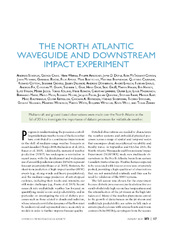The North Atlantic waveguide and downstream impact experiment
Schäfler, Andreas; Craig, George; Wernli, Heini; Arbogast, Philippe; Doyle, James D.; McTaggart-Cowan, Ron; Methven, John; Rivière, Gwendal; Ament, Felix; Boettcher, Maxi; Bramberger, Martina; Cazenave, Quitterie; Cotton, Richard; Crewell, Susannne; Delanoë, Julien; Dörnbrack, Andreas; Ehrlich, André; Ewald, Florian; Fix, Andreas; Grams, Christian M.; Gray, Suzanne L.; Grob, Johannes; Groß, Silke; Hagen, Martin; Harvey, Ben; Hirsch, Lutz; Jacob, Marek; Kölling, Tobias; Konow, Heike; Lemmerz, Christian; Lux, Oliver; Magnusson, Linus; Mayer, Bernhard; Mech, Mario; Moore, Richard; Pelon, Jacques; Quinting, Julian; Rahm, Stephan; Rapp, Markus; Rautenhaus, Marc; Reitebuch, Oliver; Reynolds, Carlolyn A.; Sodemann, Harald; Spengler, Thomas; Vaughan, Geraint; Wendisch, Manfred; Wirth, Martin; Witschas, Benjamin; Wolf, Kevin; Zinner, Tobias
Peer reviewed, Journal article
Published version

Åpne
Permanent lenke
https://hdl.handle.net/1956/20287Utgivelsesdato
2018Metadata
Vis full innførselSamlinger
- Geophysical Institute [1195]
Originalversjon
https://doi.org/10.1175/bams-d-17-0003.1Sammendrag
The North Atlantic Waveguide and Downstream Impact Experiment (NAWDEX) explored the impact of diabatic processes on disturbances of the jet stream and their influence on downstream high-impact weather through the deployment of four research aircraft, each with a sophisticated set of remote sensing and in situ instruments, and coordinated with a suite of ground-based measurements. A total of 49 research flights were performed, including, for the first time, coordinated flights of the four aircraft: the German High Altitude and Long Range Research Aircraft (HALO), the Deutsches Zentrum für Luft- und Raumfahrt (DLR) Dassault Falcon 20, the French Service des Avions Français Instrumentés pour la Recherche en Environnement (SAFIRE) Falcon 20, and the British Facility for Airborne Atmospheric Measurements (FAAM) BAe 146. The observation period from 17 September to 22 October 2016 with frequently occurring extratropical and tropical cyclones was ideal for investigating midlatitude weather over the North Atlantic. NAWDEX featured three sequences of upstream triggers of waveguide disturbances, as well as their dynamic interaction with the jet stream, subsequent development, and eventual downstream weather impact on Europe. Examples are presented to highlight the wealth of phenomena that were sampled, the comprehensive coverage, and the multifaceted nature of the measurements. This unique dataset forms the basis for future case studies and detailed evaluations of weather and climate predictions to improve our understanding of diabatic influences on Rossby waves and the downstream impacts of weather systems affecting Europe.